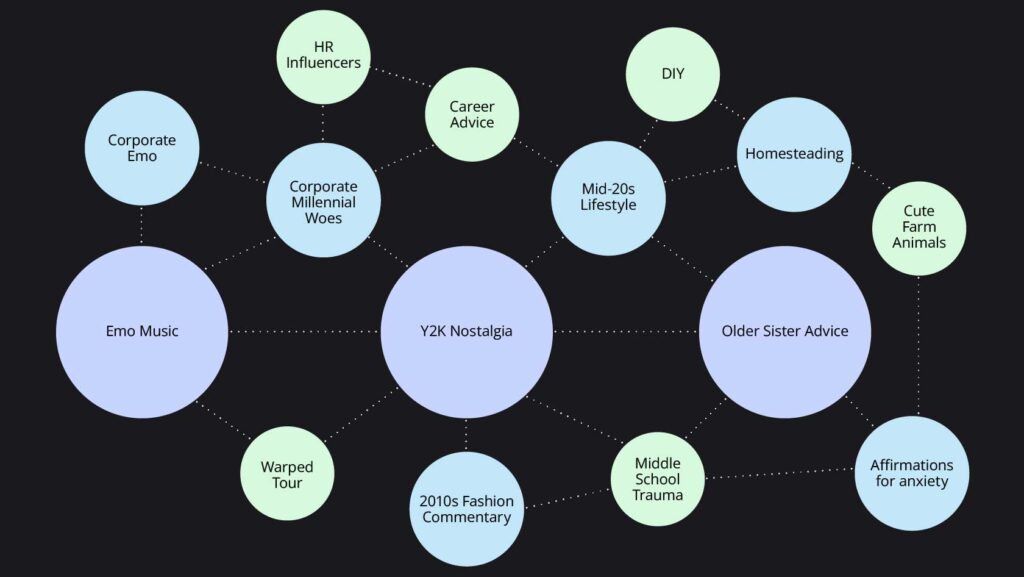What is an Interest Graph, and What Does it Mean for Marketing?
The challenge for companies in today’s marketing world is not only to produce relevant, engaging content but also to understand how to repurpose and maximize content to reach existing and new users.
Think back to the early days of Facebook. You created an account, took on the emotionally taxing process of picking a profile picture, and added some interests that made you seem cool. Then you visited your timeline to see…nothing: no pet pictures, no graduation announcements, no questionable political opinions. There was nothing but a little message: Facebook is a lot more fun with friends.
And at the time, that was true. But social media platforms have evolved to use advanced artificial intelligence strategies to understand users better and keep them online, fundamentally shifting how we experience the digital world and what businesses must prioritize to build successful social media marketing strategies.
Your Content is Served: Social Graph vs. Interest Graph
At that time, social media was somewhat of an intranet. What users saw on their timelines came from what immediate connections posted and, eventually, what they were interacting with. For example, if your Facebook friends were big fans of Fall Out Boy, Facebook would assume you were too. The platform would then more than likely serve you Fall Out Boy’s page as suggested content — even if you’d never listened to them. This earliest form of the infamous content algorithm is what we call a social graph.
However, recent AI advancements have enabled platforms to track our patterns. We are now served content from across the internet based on what AI thinks we like and what we might like — an assumption taken from what other people with similar patterns are engaging with. This new, far more customizable model is known as interest graphing.
Let’s look at an informal case study from my own TikTok For You Page (FYP), the app’s suggested content feed, as an example of how powerful algorithmic interest graphing is:
It all started with a revival of my love for emo music, including following a few of my favorite bands and watching videos with hashtags like #corporateemo and #itwasntaphase. Within a few days, my FYP began filling up with Y2K-themed videos. I soaked in the nostalgia of skits about frying my strands with a flat iron in middle school and ASMR of flip phones. Next came a hyper-niche POV series of my parasocial older sister offering advice on dealing with our overbearing parents and what would happen if I kept stealing her denim mini-skirt. In reality, I have a younger brother, so I didn’t really connect with this content. When TikTok noticed a drop-off in engagement, my FYP diluted to a broader pool of topics with which other mid-20-somethings with no fashion sense and a fear of conformity were engaging. And the cycle repeated (and continues to repeat) itself, over and over again. All told, this is probably what my interest graph looked like over the two weeks I continued to run this experiment:

How Marketers Can Leverage the Interest Graph
The transition away from social graphing presents organizations with opportunities that are both actionable and, frankly, exhilarating. Before interest graphing, low follower counts significantly hindered overall content reach on social media, limiting opportunities to reach unknown audiences organically. But the integration of artificial intelligence now allows platforms to identify and serve content to niche groups of users who are already engaging with similar and tangential topics, connecting you with more MQLs with less effort. And with interest graphs driving suggested content feeds across nearly every social media platform, building a strategy on great content has never held more potential.
Sure, targeting audiences based on who they are and what they like isn’t new. But we have to acknowledge that growing concerns over consumer data privacy have placed increasingly more limitations on how marketers can target audiences through digital advertising, both on and off social media. The good news is that while we’ve seen targeting capabilities shrink, artificial intelligence has progressed to a point where it’s more capable than ever of delivering your content to both followers and non-followers who have demonstrated an interest in similar content — no paid “boosting” required.
Nevertheless, great content isn’t cheap. Companies will need to invest more in content marketing than they have historically and understand how to get the most out of that investment. Content trends constantly change, so a robust content marketing strategy needs to marry traditional aspects like technical SEO and repurposing content with best practices for delivering the message most effectively across relevant digital channels. It’s no easy feat, but no one said you must tackle it all alone.
Partnering with an established agency like Thunderfoot and its tightly integrated teams of writers, marketers, and social media strategists can help you create and maximize content in this evolving digital landscape to resonate with your user base and drive results.
Get in touch with us today to learn how we can help your company grow.
Related Insights
We’re looking forward to working with you, too.
Start conquering the digital terrain today.





